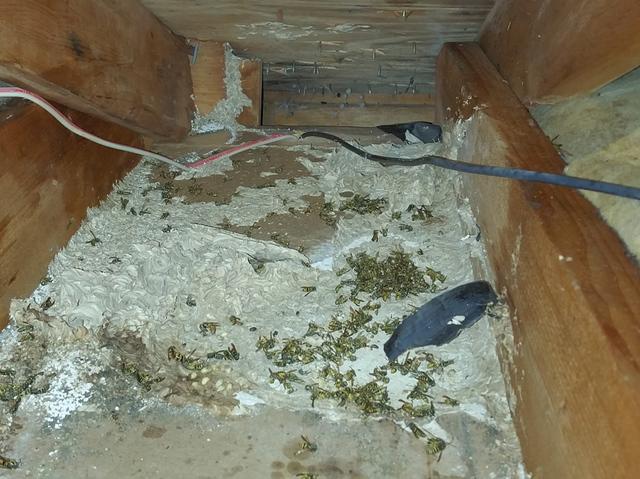European Hornets in Middletown Attic Scare Residents - Hornet & Bee Control in Middletown, NJ
Challenge
I was dispatched to a Middletown residence on Saturday to inspect and treat what the homeowners believed was a yellow jacket infestation. They were concerned after seeing stinging insects hovering around the windows in a bedroom. Upon arrival, I spoke with the homeowners and inspected the room. There were no signs of any nests, there were no live insects in the room, and I could not affirmatively identify the particular insect because the dead ones had already been cleaned up. But I did notice potential entry points in the ceiling. The bedroom had a ceiling fan and high hat (recessed) lighting. In all likelihood, these insects had made their way into the living spaces from the attic. Sure enough, once in the attic, my suspicions were confirmed. It was immediately apparent that they were nesting in or around the soffit area. After a little poking and prodding of the insulation, I narrowed it down to one specific line of insulation.
Solution
After using a knock down agent, I was able to identify the infestation. They weren’t yellow jackets. These guys were European hornets. European (Giant) hornets, like yellow jackets, paper wasps, and bald-faced hornets, are wasps. These are large stinging insects, about an inch long, and they will aggressively defend their nests. European hornets are the only true hornets in the United States. Bald-faced hornets, despite their name, are not hornets; they are a type of yellow jacket. European hornets have orange, brown, and yellow markings. Because they have a bit of yellow in them, it’s easy to confuse these insects with yellow jackets. A pest control professional can identify the difference between the two based on size, shape, and markings. For homeowners, the difference is not all that important. It’s enough to know that either of them are aggressive stinging insects, and any indoor nests should be removed by a pest control professional with the equipment and experience to do it safely. A common DIY mistake is to plug the hornet’s entrance. These insects are more than capable of chewing through sheet-rock and entering the living area in an attempt to escape.
With European hornets, you’ll rarely see a freely suspended football-shaped nest that associated with yellow jackets and bald-faced hornets. Instead, they like to build their nest in a cavity of some sort, often a wall void. Hornet nests can be difficult to reach and treat. And let’s just say that these insects are highly territorial and don’t appreciate it when someone is snooping around. With this home in Middletown, I had the unenviable task of locating a nest in an enclosed attic with insects buzzing everywhere. I treated the nest area with a knock down and a residual application. In a couple of days, once everything has quieted down and the hornets are dead, I’ll return to safely remove the nest.



